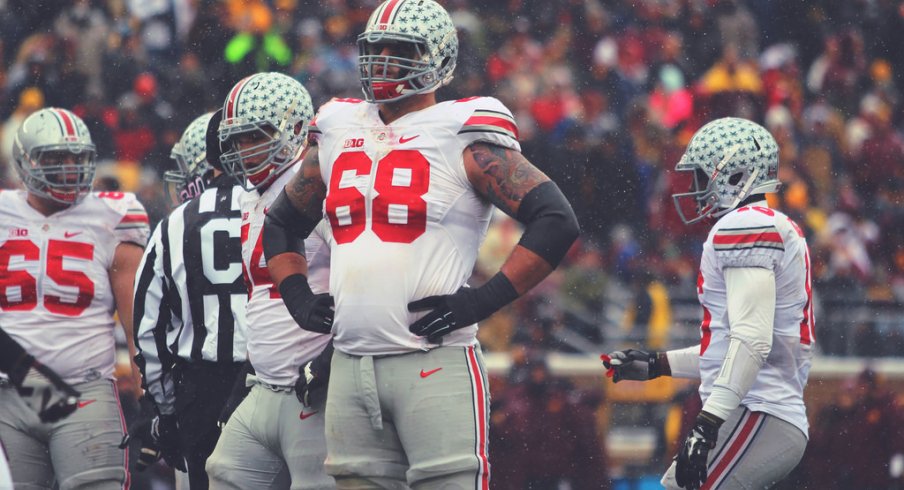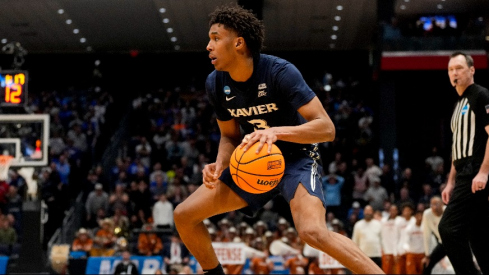Breaking news: Ohio State's offensive line was pretty good last year.
Sometimes, great deeds need time and distance for their impressiveness to sink in. More than a month after the end of college football season, the Buckeyes were making headlines for their impressive feat: committing two holding penalties all year.
Given how many snaps an offensive line takes over the course of a season, that is an incredible number. But that number is free of context, one that raises questions. Is Ohio State alone in having such low numbers? Was Ohio State disciplined across the board, or did they just get lucky? Are holding calls so much more common? Why didn't the Slobs win national awards? Might there be another, better offensive line out there?
With those questions in mind, I set out to compare the Slobs' achievements to their peers. My conclusion: Ohio State's offensive line was, if not the most talented, the most disciplined in the country.
How do you tell if an offensive line is any good? More than any other position on the gridiron, offensive line is a combined effort. Four of the five linemen can be great, but if the fifth man botches an assignment, the play is blown up.
With only a few exceptions, there are four kinds of penalties an offensive lineman can commit that have to do with them blocking a defender: holding penalties, false starts, illegal blocks (of the 15-yard variety) and personal fouls. For the this article, I define these as "discipline penalties".
| Details | |
|---|---|
| Holding | 2 (Billy Price vs. Navy; Taylor Decker vs. Cincinnati) |
| False Starts | 17 (Billy Price vs. Navy, VT, Rutgers, Michigan; Taylor Decker vs. VT, Cincinnati, Maryland, Wisconsin 2x; Pat Elflein vs. Cincinnati, Rutgers, Minnesota, Indiana; Unknown 5x) |
| Illegal Blocks | None |
| Personal Fouls | 2 (Jacoby Boren vs. Michigan; Unknown vs. Michigan State) |
| Total Penalties | 21 (5 for Billy Price, 5 for Taylor Decker, 4 for Pat Elflein, 1 for Jacoby Boren, 6 for Unknown) |
Ohio State's offensive line had 15 to 21 such penalties in 2014, with six penalties going unattributed in the play-by-play. Billy Price and Taylor Decker led the way with five apiece, Pat Elflein had four, and Jacoby Boren had one. Darryl Baldwin, the starting right tackle, was not credited with with a discipline penalty, nor were any backups.
Though the eye test might still be the most reliable way to judge offensive lines, it is not infallible. A bad offensive line can be disguised by a running back who can plow forward after contact or a quarterback with a quick delivery; a good offensive line can be masked by a running back who misses holes or a quarterback with no pocket presence.
One useful tool for evaluating an offensive line is Adjusted Line Yards. A metric invented by Football Outsiders, Adjusted Line Yards attempts to separate the running back's skill from the offensive line's skill, accounting for the opponent's strength with decent results. The Buckeyes were special here in 2014, finishing second in in the country.
A similar statistic is Adjusted Sack Rate, which shows how often a quarterback is sacked. The Buckeyes do not fare so well here, finishing 74th in Adjusted Sack Rate (though much of that is a result of J.T. Barrett and Cardale Jones's scrambling). It is less accurate as a measure of an offensive line's worth than Adjusted Line Yards, though.
I compared the Buckeyes to their peers, the top five teams in Adjusted Line Yards (Oregon, Georgia Tech, Georgia, Auburn and Alabama). For kicks, I threw New Mexico State (the top-rated team in Adjusted Sack Rate) into the mix. The goal: to determine, based on play-by-play data, how disciplined each team was.
There are pre-snap penalties that could be used to show discipline, like illegal shifts or too many men in the backfield, but those deal with alignment, not engaging defenders. Declined penalties and penalties committed by non-linemen are ignored as well.
You probably don't care as much about the nitty-gritty for six other schools, so let's condense their data into one snazzy chart (attributed penalties in parentheses):
| Oregon | Georgia Tech | Georgia | Alabama | Auburn | NMSU | |
|---|---|---|---|---|---|---|
| Holding | 22 (13) | 5 (4) | 6 (5) | 4 (4) | 8 (7) | 4 (2) |
| False Starts | 27 (11) | 13 (12) | 10 (8) | 11 (11) | 9 (5) | 20 (14) |
| Illegal Blocks | 0 | 3 (2) | 1 (0) | 1 (1) | 0 | 1 (0) |
| Personal Fouls | 1 (1) | 2 (1) | 0 | 1 (1) | 2 (0) | 1 (1) |
| Total Penalties | 50 (25) | 23 (19) | 17 (13) | 17 (17) | 18 (12) | 26 (17) |
Oregon's offensive line was the top-rated team for Adjusted Line Yards, but it committed 25 to 50 penalties. Given the blazing pace at which the Ducks operate, it makes sense that they would have more false starts, but they have far more holding penalties than any other team.
Georgia Tech's offense is founded on a keen triple option attack, one that relies on a disciplined offensive line. The numbers bear that out; there are more false starts because the Yellow Jacket offense requires more presnap motion. Even so, the Buckeye line was a cut better than Georgia Tech's cut blockers.
New Mexico State is an oddball, since it finished 4-8 playing against weak competition. Even so, its base numbers are impressive. One lineman accounted for both of the confirmed holding penalties, and the Aggie line committed only 17 to 20 non-holding calls. NMSU had an offensive line to rival the big boys... as long as you ignore that it was 117th in Adjusted Line Yards.
That leaves Alabama, Georgia and Auburn as the three challengers to the Slobs. This requires another step: comparing confirmed penalties to tempo.
| Oregon | OSU | GT | UGA | BAMA | AUBURN | NMSU | |
|---|---|---|---|---|---|---|---|
| Total Plays | 1118 | 1099 | 993 | 877 | 1018 | 939 | 921 |
| Confirmed O-Line Penalties | 25 | 15 | 19 | 13 | 17 | 12 | 17 |
| Plays Per Penalty | 44.72 | 73.27 | 52.26 | 67.46 | 59.88 | 78.25 | 54.18 |
Alabama had (and will continue to have) peerless offensive line talent. Its offensive line was better at avoiding false starts than The Slobs were, but the Crimson Tide were sloppy early in the year. Adjusting for tempo, the Crimson Tide averaged a penalty every 59.88 plays, worse than Ohio State's mark.
Rimington Award finalist David Andrews led Georgia's line, and the Bulldogs had three spotless games. But their penalty numbers are deflated by a slow tempo, and they held more often than Ohio State.
Auburn was the most disciplined team in this survey with only 12 attributed penalties. The Tigers' average plays per penalty (78.25) is also better than Ohio State's (73.27). One concern: Auburn committed four unattributed discipline penalties in the Outback Bowl. If a lineman committed any of them, Ohio State is back on top.
Some of the results defied expectations. Georgia's o-line had fewer discipline penalties than the Buckeyes, Auburn's line was called for penalties less often than Ohio State's line was, and New Mexico State's o-line may have matched the Slobs for holding calls.
It is difficult to quantify how good an offensive line is. Most analyses rely on the eye test, since technique and positioning are the two most important factors to a play's success or failure. To play-by-play's credit, it's better than nothing and it avoids subjectivity.
When all is said and done, Ohio State's offensive line was called for penalties less frequently than its peers, with the possible exception of Auburn. The discipline of the 2014 offensive line, especially after breaking in four new starters, was something to behold.


